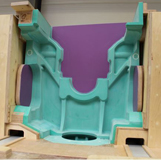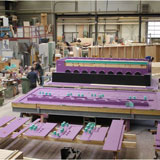Model Maker programs its 5 Axis Milling Machines with WORKNC
The WORKNC CAD/CAM system is suitable for small and large machines. It is used in precision engineering as well as for large model construction as it is in the Duisburger Modellfabrik workshop in Germany. There, WORKNC generates highly automated safe, collision-free toolpaths for 5 axis milling centers with a cutting area of up to 5.10 x 3.70 m.
"We have been working with the 3 axis WORKNC Module for a long time and have been using the 5 axis module for about six years now. We are totally satisfied with this CAM software because it generates totally collision-free NC programs, virtually at the push of a button. This is particularly important on our huge parts. What’s more, we can simulate the complete milling process and therefore pre-control the process."
Mirko Müller, Duisburger Modellfabrik GmbH
Duisburger Modellfabrik GmbH has specialized in large foundry models in wood, plastic blocks or foam material needed for applications such as machine beds, diesel engines or components for wind turbines. Dimensions measuring several meters in width, height and depth are not uncommon. CEO Herbert Schild had his first close contact with milling in his second company which handles illustrative model making in the same premises. It produces what are known as packaging models made of Plexiglas, mostly made by CNC machining. Having seen this technique used on a daily basis, Herbert Schild thought he would try applying it to large models. Herbert Schild therefore decided to purchase his first CNC milling machine. However, the foundry model makers soon realized that they needed a powerful CAD/CAM system, which could provide different milling strategies, such as constant Z-level machining and rest material recognition.
WORKNC: Short Learning Curve – Big Returns
“WORKNC was the first and only one which immediately convinced us. Even during the first presentation, the company was able to demonstrate, on our own parts, how easy to use WORKNC is.” explains Herbert Schild. This impression was confirmed over the following weeks. “Although we still hadn’t much of an idea about CAM programming, we obtained respectable results after a short learning period.”
From 2005 to 2008, Duisburger Modellfabrik perfected their CAD CAM skills machining smaller components. Then the time was ripe for a large 5 axis CNC gantry machining center from CMS whose performance is tailored to model making. At the same time, Herbert Schild ordered the WORKNC 5 axis module to fully exploit the capabilities of his new CMS milling center. “The moment was just right”, says the manager, “we were receiving more and more orders from wind power companies and in this industry you can no longer work without CAD/CAM and milling. 3D CAD models are dominant; a drawing is only incidental.”
In the interim, Duisburger Modellfabrik has converted and adapted the whole operation to CNC technology. This does not mean that every large part is completely finished by the milling machine. Herbert Schild and his team have developed a modular system in which a partially hand-crafted yet very precise body forms the basis. Then milled components such as high ribs are added.
Computer Aided Processes
Even if some manual work is still required, CAD and CAM are used throughout the whole process chain. Many customers provide a three-dimensional data model. If only drawings are available as a base, the model making specialists design it themselves. To ensure the company was equipped with the latest software tools, the VISI CAD system was introduced last year. Like WORKNC, this software is developed by the Vero Group, one of the world’s fastest growing CAD/CAM software providers for tool and die making. Herbert Schild explains: “We use VISI, which was recommended by a good customer, mainly for model design tasks. Milling is still carried out using WORKNC, which remains the best solution for our purposes. VISI and WORKNC now belong to the same software house (Sescoi was acquired by Vero in late 2012). This is beneficial for us, i.e. for interfaces, etc.”
The engineering team prepares the model in CAD, including typical machining allowances and adding fillets, radii and draft angles and then the stock is created. From the CAD data transferred to the CAM software, the milling programs are then generated. WORKNC, which since its creation, has specialized in tool, mold and model making applications, provides automatic strategies and machining processes for all CAD surface and solid models. These automated strategies allow even novice CAM users to create toolpaths within a few minutes. Experienced CAM users also can bring their expertise to WORKNC and, using the various strategies, achieve optimum machining speed and quality.
Meanwhile, the number of machines at the company has significantly increased. Two other 5 axis milling machines from an Italian manufacturer have been added to the Kitamura, which is still in use, and the first CMS gantry milling center. Herbert Schild is enthusiastic about these machines: “CMS builds great machines that are perfectly adapted to our needs, e.g. lightweight construction. That is why we now have three machines with different capacities. The smallest one has a cutting area of 3.80 x 1.50 m, the next one 4.80 x 1.80 m and the biggest 5.10 x 3.70 m. The Z-height is between 1100 and 1250 mm. For the base body construction, we now have another 2D panel milling machine which is also programmed via WORKNC.”
Collision-free and easy to use
This construction task is carried out at Duisburger Modellfabrik by Mirko Müller and Martin Herx. They agree that WORKNC is very well suited for large size model making. Mirko Müller explains: “We have been working with the 3 axis WORKNC Module for a long time and have been using the 5 axis module for about six years now. We are totally satisfied with this CAM software because it generates totally collision-free NC programs, virtually at the push of a button. This is particularly important on our huge parts. What’s more, we can simulate the complete milling process and therefore pre-control the process.” “Even the stock model management in WORKNC is unique”, Martin Herx added. “By the continuous comparison of the stock and holder, rough machining is totally secure at all times. While you still have to enter numerous values in other software, these requirements are minimal in WORKNC."
Currently, WORKNC version 22.4– with 64 bits and multiprocessor capabilities - is installed. Another reason why Duisburger Modellfabrik is so happy to work with WORKNC is its wide range of efficient 2, 2.5 and 3D machining strategies and advantageous automated solutions for 3, 4 and 5 axis machining. “We mainly use 3 axis milling and 5 axis milling with an inclined axis because in this way, we are chipping much faster than with simultaneous 5 axis techniques. We only use these if it is mandatory for the surfaces”, state the two WORKNC operators. They find the effective rest material machining cycles of the software extremely practical as they avoid air cutting and therefore ensure quick machining times.
The hole drilling feature in WORKNC is another time saver. When, in addition to 3D milling you can automatically perform all the hole features with the software, this reduces the workload and saves time. All the relevant features of the component are recognized in WORKNC, then the available tools are defined and the software adds the cycles to the program. The user does not have to input the coordinates or carry out any programming on the machine controller.
About the Company
Name: Duisburger Modellfabrik GmbH
Web: www.duisburger-modellfabrik.de
Benefits Achieved
- Reduced programming times
- Generates totally collision-free NC programs, virtually at the push of a button
- Even novice CAM users can create toolpaths within a few minutes.
Comments
"We have been working with the 3 axis WORKNC Module for a long time and have been using the 5 axis module for about six years now. We are totally satisfied with this CAM software because it generates totally collision-free NC programs, virtually at the push of a button. This is particularly important on our huge parts. What’s more, we can simulate the complete milling process and therefore pre-control the process."
Mirko Müller, Duisburger Modellfabrik GmbH











